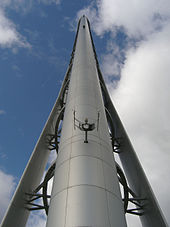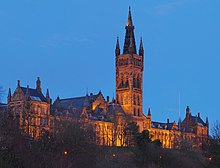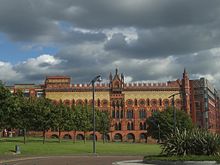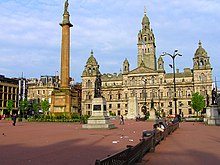Glasgow
![]()
This article is about the city in Scotland. For other meanings, see Glasgow (disambiguation).
Glasgow [ˈɡlazgəʊ or ˈglɑːzgəʊ] (Scots: Glesga, Scottish Gaelic: Glaschu, officially City of Glasgow) is Scotland's largest city, with a population of over 630,000, ahead of Edinburgh, and the third largest city in the United Kingdom after London and Birmingham. The city forms one of the 32 Council Areas in Scotland and is situated on the River Clyde. In the late 19th and early 20th centuries, Glasgow had a population of more than one million. In 2017, the Greater Glasgow and Clyde Area had a population of 1,169,110.
Glasgow is considered a "working class" city, unlike the Scottish capital Edinburgh. Glasgow has a 12th century cathedral and four universities (University of Glasgow, University of Strathclyde, Glasgow Caledonian University and the University of the West of Scotland) as well as the Glasgow School of Art and the Royal Conservatoire of Scotland (formerly the Royal Scottish Academy of Music and Drama).
In a 2018 ranking of cities by their quality of life, Glasgow came 50th out of 231 cities surveyed worldwide.

Glasgow coat of arms
Geography
Climate
| Glasgow | ||||||||||||||||||||||||||||||||||||||||||||||||
| Climate diagram | ||||||||||||||||||||||||||||||||||||||||||||||||
| ||||||||||||||||||||||||||||||||||||||||||||||||
| Monthly average temperatures and precipitation for Glasgow
Source: | ||||||||||||||||||||||||||||||||||||||||||||||||||||||||||||||||||||||||||||||||||||||||||||||||||||||||||||||||||||||||||||||||||||||||||||||||||||||||||||||||||||||||||||||||||||||||||||||||
History and foundation of the city
For thousands of years, people have settled on the site of present-day Glasgow, with the Clyde providing ideal conditions for fishing. Around 80 AD the Romans settled the site, which was probably called Cathures at the time. Later, the Romans built the Antonine Wall, the remains of which can still be seen in Glasgow today, around 140 AD to separate Roman Britain from Celtic and Pictish Caledonia. Glasgow itself was founded by the Christian missionary Saint Mungo (also known as Saint Kentigern) in the 6th century. He built a church on the site of the present cathedral, and in the years that followed Glasgow became a religious centre. The miracles attributed to Saint Mungo are still reflected in the city's coat of arms.
Medieval
Glasgow's history is vague until it grew into a city in the 12th century and the building of St Mungo's Cathedral began. In 1451, the University of Glasgow was founded by papal decree. By the early 16th century Glasgow had become a major religious and academic centre.
Trade and industrial revolution
Also by this time, the city's merchants and skilled workers had grown to considerable influence, which began to diminish the power of the church. With shipping on the Clyde, Glasgow became a busy trading centre and the gateway to Edinburgh and the rest of Scotland.
Glasgow's position at the centre of the British Empire also made it the central hub for trade with the British colonies. Easy access to the Atlantic Ocean facilitated the import of American tobacco, which was then sold throughout Europe. Trade with the Caribbean allowed the importation of sugar. From the 1770s, the desilting of the Clyde allowed larger ships to sail further up the river, laying the foundations for industrial and shipyard construction during the 19th century.
Due to the abundance of coal and iron from Lanarkshire, Glasgow became an industrial city, nicknamed the "second city of the Empire". The cotton industry and textile manufacturing also flourished. Workers from Scotland, Ireland and the rest of Europe were drawn to the burgeoning city. They often had to settle in overcrowded quarters with poor housing such as the Gorbals. Glasgow still had the highest population density of any major British city after the Second World War: there were 36.2 people per acre here; in Liverpool, 31.5; in Manchester, 28.1; and in Edinburgh, 13.5. The Industrial Revolution made Glasgow one of the richest cities in the world at the time. Wealthy merchants financed spectacular buildings, parks, museums and libraries. Factories were built as veritable splendours, such as a carpet factory (Templeton's carpet factory) designed as a copy of the Doge's Palace in Venice. Major international industrial exhibitions were held here, for example in Kelvingrove Park in 1888 and the Empire Exhibition in Bellahouston Park in 1938.
Glasgow also became an important cultural centre. Numerous galleries settled here and extraordinary buildings were erected, such as the Glasgow School of Art, built by Charles Rennie Mackintosh, or the Willow Tearooms (now reconstructed) by the same architect.
Postwar
On 31 January 1919, tanks were used against strikers in favour of the 40-hour week in what became known as the 'Battle of George Square'. After the First World War, Glasgow suffered from the global economic decline. Although ships and trains continued to be manufactured in Glasgow, cheaper labour outside the city became competition. The situation of the working class in the city became more acute, and an awareness of their own situation developed. Labour became increasingly politicised. For example, Glasgow workers sent an entire brigade to support the Spanish Republic in the Spanish Civil War of 1936-1939. From the 1960s, the city's economy went into a steep decline.
In the 1970s and 1980s, steel mills, coal mines, engine plants and other heavy industry closed in and around Glasgow, leading to mass unemployment and decay in the city. Despite new ships being built, such as the Queen Elizabeth 2, one shipyard after another closed. By the turn of the millennium, only two shipyards remained, both funded entirely by government defence contracts. Since the mid-1980s, however, there has been an arduous recovery through structural change towards the service industry - a financial district was created. The former factory sites in the suburbs have been occupied by the entertainment industry.
Since 1990
In the 1990s, Glasgow steadily recovered from its decline. The city has invested large sums in the renovation and restoration of a large number of buildings over the past 15 to 20 years. This effort has noticeably improved the quality of life in the city. In 1990, Glasgow (instead of London or Edinburgh) surprisingly became the 6th European Capital of Culture and was awarded the title of UK City of Architecture and Design in 1999. In 2003 Glasgow became European Capital of Sport. With the structural change Glasgow also got a modern cultural and congress centre, where many different events take place, including such as the Science Fiction World-Cons "Intersection" in 1995 and "Interaction" in 2005 with about 4000 participants. Tourism, sporting events and large conferences characterize the image of modern Glasgow.
Especially worth mentioning is the variety of museums in Glasgow, almost all of which can be visited for free. One exception is the Glasgow Science Centre, which charges admission. Important museums in Glasgow are the Kelvingrove Art Gallery and Museum, the Hunterian Museum and Art Gallery (at the University of Glasgow), the Centre for Contemporary Art (CCA) and the Burrell Collection. The latter is the private collection of William Burrell, who bequeathed it to the city.
With the Glasgow Science Centre, the Glasgow Tower by Richard Horden and the Clyde Auditorium by Norman Foster, the city also has some modern architecture to offer.
Yet, according to a study by the ONS, 30.2% of all homes were occupied by unemployed families in 2012. Many of the city's residents have no stake in the recovery. In neighbourhoods such as Calton, due to the decline of the Scottish steel industry and consequent phenomena such as mass unemployment, poverty, social misery and widespread alcoholism, statistical life expectancy is 53 years. This high mortality rate, also in comparison with other deindustrialised British cities, is also referred to in medicine as the Glasgow effect. The reason for this is the generally higher mortality rate in Scotland compared to England and Wales. Specifically in Glasgow and the surrounding region, increased levels of long and severe illnesses, cancer, alcoholism and mental illnesses, especially in men, were found. A medical report gives the following as reasons: the particularly high population density in Glasgow from the outset compared to other British cities, the strategy pursued since the 1950s by the London Scotland Office of settling educated workers in new housing estates on the outskirts of the city, where the unskilled workers remained, the construction of many high-rise buildings, which was unusual by British standards, and the policy of Glasgow city councils since the 1980s, which focused more on property formation and demolition of tenement buildings than on their qualitative improvement.
Youth crime is widespread. Peripheral neighbourhoods such as Drumchapel, Castlemilk and Easterhouse are particularly affected. However, for most young people, involvement in a youth gang is a rite of passage and they drop out after a while; staying or growing into organised crime is less common than in other cities. Glasgow has long been the area with the highest percentage of murders within the UK. In 2007, there were 4.5 murders per 100,000 residents. In 2012, the rate dropped to 2.7 murders, but was still well ahead of London with 1.67 murders and the national average of 1.0 murders.
A report into the potential impact of Brexit on Glasgow is calling for the Scottish and UK governments to provide targeted support to the region, in particular a full replacement of grants from the EU.

Glasgow Tower

Glasgow Science Centre

Scottish Exhibition and Conference Centre Footbridge

Glasgow University

Templeton's Carpet Factory

George Square and City Chambers
Questions and Answers
Q: What is the population of Glasgow?
A: The number of people living in Glasgow is 621,020 (2017 estimate) and 626,410 (2019 estimate). Many more people live in the areas round the city. There are 1,209,143 people living in the Greater Glasgow urban area. The wider metropolitan area is home to over 1,670,000 people, about 33% of Scotland's population.
Q: How did the population change during the 1960s?
A: Starting in the early 1960s the old tenements were pulled down and new housing built further out (high-rise blocks were the fashion of the day). Now there is nowhere near the number of people living in Glasgow as during its famous times of shipyards on River Clyde.
Q: What are some popular tourist attractions in Glasgow?
A: Popular tourist attractions include Loch Lomond and Western Isles which can be accessed by one of oldest paddle-steamer boats located in Glasgow. Additionally there are a number of theatres and concert halls such as SECC (Scottish Exhibition and Conference Centre), Royal Concert hall, King's Theatre, Pavilion Theatre and Theatre Royal for visitors to explore.
Q: What type of climate does Glasgow have?
A: Glasgow has an oceanic climate (Cfb in Koeppen climate classification). The weather changes often with damp mornings that may be misty or foggy; this dreich weather is also referred to as "The Glaswegian Patter". However it usually improves through afternoon with dry temperatures at an average level.
Q: How many football teams play within city limits?
A: There are several football teams playing within city limits including Rangers F.C., Celtic F.C., Partick Thistle, Clydebank and Queens Park F.C..
Q: What airports serve Glasgow?
A: Two airports serve Glasgow -Glasgow International Airport and Prestwick Airport .
Q: Where are main railway stations located?
A: Main railway stations located within city limits are Central Station and Queen Street Station providing rail links to rest Scotland , UK & Europe
Search within the encyclopedia